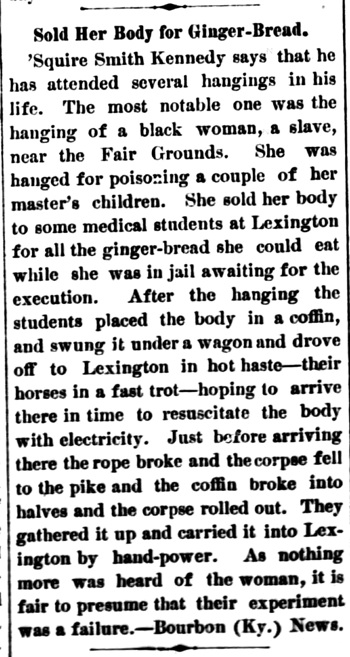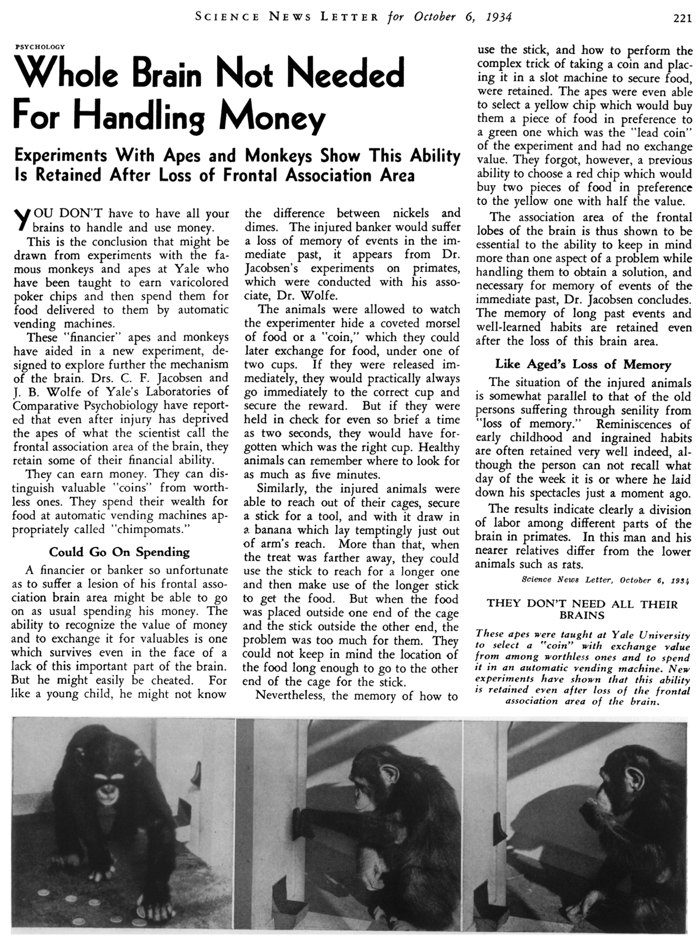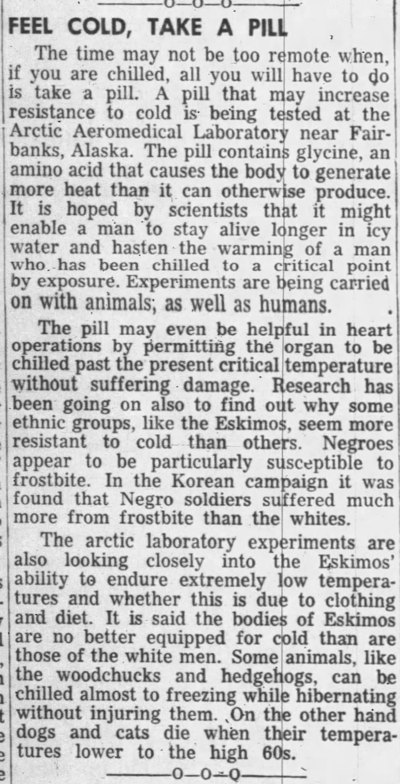Experiments
She sold her body for gingerbread
Requesting "all the ginger-bread she could eat" in exchange for her body after death initially struck me as a bizarre detail. But the more I think about it, the more reasonable it seems given that condemned prisoners often request cookies, candy, junk food, etc. as their last meal.
Whiting Weekly News - Jan 25, 1890
Posted By: Alex - Sat Nov 18, 2023 -
Comments (1)
Category: Death, Food, Prisons, Experiments, Nineteenth Century
Whole brain not needed for handling money
Mention to any friends who are bankers or accountants that science has shown they could have a frontal lobotomy and still do their job, and see how they react.
Click to enlarge
Posted By: Alex - Mon Sep 04, 2023 -
Comments (0)
Category: Money, Experiments, Psychology, 1930s
Warming Pills
Glycine is readily available as a supplement. I hadn't heard about its supposed warming properties.
Scranton Times-Tribune - July 25, 1957
I searched for the research that inspired the newspaper report above and found a 1956 study, conducted at the Arctic Aeromedical Laboratory, that involved immersing dogs in freezing water. The researchers measured how long it took for the rectal temperature of the dogs to lower to 26°C. Dogs that had been given glycine took longer to chill (and warmed up more rapidly) than the control group:
The intravenous administration of a 5% glycine solution caused a significant increase of 34.6 minutes in the time required to lower the rectal temperature of dogs from 38°C to 26°C. Total rewarming time was decreased by 34.3 minutes in the glycine treated group. The differences in cooling and rewarming rates between the treated and non-treated animals was due to the increased heat production observed in the dogs receiving glycine. The possible applicability of thermogenic agents in accidental hypothermia is discussed.
However, I then found a 1961 study, also from the Arctic Aeromedical Laboratory (but this time conducted on humans) that seemed to cast doubt on the warming properties of glycine:
I think I'll stick with whiskey for warmth.
Posted By: Alex - Tue Aug 15, 2023 -
Comments (3)
Category: Experiments, 1950s
Result of artificial sleep in a biological experiment
In the 1950s, reports came out of the Soviet Union about an unusual experiment in which a dog's life was radically lengthened by putting it into an artificial sleep for three months.The research was done by S.N. Braines (I have no idea what "S.N." stands for). I believe that he reported his results in a 1952 article titled, "Result of artificial sleep in a biological experiment," published in a Soviet journal. But I can't be sure because I can't find the text of the article.
The results he achieved sound unlikely to me.

Omaha World-Herald - Oct 17, 1958

Text from Main Street, U.S.S.R. (1959), by Irving R. Levine
Posted By: Alex - Wed Jul 26, 2023 -
Comments (3)
Category: Sleep and Dreams, Experiments, Dogs, 1950s, Longevity
Finger Injuries Caused by Power-Operated Windows
The next time you use the power windows in your car, think about the cadavers that suffered injuries to make them safe for you.Source: Injury journal

via New Scientist
Posted By: Alex - Mon Jul 17, 2023 -
Comments (3)
Category: Body, Experiments, Cars
Death Valley Moon Test
July 1968: It was widely reported that Kathie Pieper, recent winner of the Miss AAU California beauty contest, would be participating in a hike through Death Valley. The hike was said to be part of an experiment conducted by researchers at the California Institute of Technology, in cooperation with the Jet Propulsion Laboratory, that would have "something to do with testing clothing and other equipment that could be used if man ever landed on the moon." Pieper agreed to go on the hike after being contacted by a JPL official who told her she was "just the type of girl they were looking for."See below in extended for the follow-up.

The Fresno Bee - July 19, 1968
More in extended >>
Posted By: Alex - Thu Jul 13, 2023 -
Comments (2)
Category: Deceit, Trickery, Subterfuge and General Slyness, Experiments, 1960s
British Rail’s Train Safety Experiment
Jan 1993: In order to find out how close workers could safely stand by the tracks while the new high-speed trains were going by, British Rail announced it would conduct an unusual experiment. It would tether employees to wooden posts located around six feet from the tracks and then measure the force of the slipstream on them as the trains went by at 140 mph.Although members of the public weren't invited to participate in the experiment, about 50 of them volunteered to be guinea pigs anyway.

Sunday London Telegraph - Jan 31, 1993
It was difficult to find out the results of the experiment, but after some digging I located a postscript printed in the Magazine of the Pennine Railway Society. The test never took place. Faced with widespread criticism, British Rail's Health and Safety Executive cancelled it.
Barmy BR proposed to tether workers to trackside posts as high-speed trains thundered past at 140mph. Bosses wanted human guinea pigs to stand as close as 6ft 6in to the expresses to test the effect of their slipstream. Rail
union chief Jimmy Knapp branded the idea barmy and suggested BR use Transport Secretary John MacGregor instead.
The workers would have been attached to posts by special harnesses that would allow them to move to the side but not forward. They would have been asked for their reaction after the trains had roared past. The tests would have helped to determine the distances from trains at which staff could work in safety. They would have taken place between York and Darlington.
However the Health and Safety Executive banned the scheme. The tests have been postponed pending further discussions to see how BR could get the information another way.
One disgruntled railwayman described the scheme as harebrained and said he joined BR to drive a flipping engine, not to play flipping bondage games. However a number of civilians have volunteered to take part in the scheme, preferably dressed in leather and chained from head to toe.
The effect when someone stands in the slipstream of a high-speed train is likely to be they'd get sucked under it. If tied to a post perhaps it would suck their boots off, or maybe they'd go blue in the face.
The idea is on a par to that of abolishing the timetable to stop the trains running late.
Posted By: Alex - Mon Jul 03, 2023 -
Comments (2)
Category: Experiments, Trains and Other Vehicles on Rails, Transportation, 1990s
The Tumpline Hypothesis
The great houses of Chaco Canyon (New Mexico) were built around 1000 years ago, using the wood of over 200,000 trees. However, the trees were about 70 miles away from the houses. So how did the Chacoans get the wood to the construction site? There's no archaeological evidence the wood was dragged, and the Chacoans had no draft animals or wheels.According to the Tumpline Hypothesis, the Chacoans used tumplines, which are straps that go over the head and can be used to carry heavy weights. From Ars Technica:
Posted By: Alex - Tue Apr 25, 2023 -
Comments (1)
Category: Science, Anthropology, Experiments
The influence of odors on creative thinking
There have been a variety of studies examining how psychoactive drugs affect behavior and creative output. But could smells also have a psychoactive effect? That was the question posed in a 1958 experiment conducted by scientist Leo H. Narodny — published in an obscure trade journal, The Perfumery & Essential Oil Record. Narodny wrote: "It may be possible, by inhaling certain odours, to influence creative imagination without endangering the whole brain by an excessive dosage of drugs."He used a textile designer as his test subject. Every day, for two weeks, he had her draw a design while breathing unscented air. Then, after breathing in air saturated with an odorous essential oil (such as bergamot, vanilla, peppermint, or cedarwood), she drew a second design. Some of the results are below.



It was hard to draw conclusions based on such a small sample size, but Narodny felt that the designer tended to draw more abstract patterns when exposed to the essential oils.
Nadia Berenstein offers more details about the experiment on her "Flavor Added" blog.
Posted By: Alex - Sat Mar 25, 2023 -
Comments (2)
Category: Art, Experiments, Psychology, Smells and Odors
Jalaproctitis
Jalaproctitis is the medical term for the rectal burning sensation often experienced by people when they defecate after having eaten jalapenos. It was given this name by researchers at the University of Texas who conducted an experiment to study the effects of jalapenos (whether it acted as an expectorant, caused painful urination, and burning defecation). From the New England Journal of Medicine (Nov 16, 1978):After giving informed consent, subjects consumed as many large jalapenos as could be tolerated in a three-minute period. The number of peppers consumed ranged from three to 13, with a median of five. Three of the participants noted lacrimation and rhinorrhea immediately after the contest. In none did cough or sputum production develop. One male subject complained of dysuria, and four of five noted a burning discomfort on defecation within 24 hours of the contest.
The limited information obtained from this study does not indicate clinical usefulness of jalapeno as an expectorant. We believe that jalapenos may well be the cause of transient dysuria and, in addition, may result in a syndrome of burning defecation that might appropriately be termed "jalaproctitis."
Posted By: Alex - Sat Mar 18, 2023 -
Comments (3)
Category: Food, Experiments, Body Fluids, Excrement, Pain, Self-inflicted and Otherwise

| Who We Are |
|---|
| Alex Boese Alex is the creator and curator of the Museum of Hoaxes. He's also the author of various weird, non-fiction, science-themed books such as Elephants on Acid and Psychedelic Apes. Paul Di Filippo Paul has been paid to put weird ideas into fictional form for over thirty years, in his career as a noted science fiction writer. He has recently begun blogging on many curious topics with three fellow writers at The Inferior 4+1. Contact Us |




